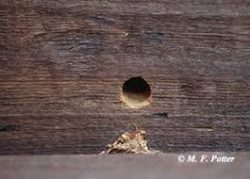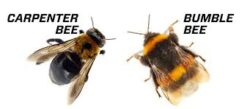Truly Green Pest Control - Carpenter Bees
 Carpenter bees damage wooden structures by tunneling into timber and siding to build their nests. This activity weakens the wood and leaves behind noticeable holes and surface stains. They typically choose bare, dry, and unpainted wood without bark for nesting. Common targets include dead tree limbs and lumber made from softwoods like southern yellow pine, white pine, redwood, cedar, Douglas fir, cypress, mimosa, mulberry, ash, and pecan. Most hardwoods are generally avoided. While their presence around homes and wooden buildings can be bothersome or intimidating, male carpenter bees cannot sting, and females will only sting if they are handled or feel threatened.
Carpenter bees damage wooden structures by tunneling into timber and siding to build their nests. This activity weakens the wood and leaves behind noticeable holes and surface stains. They typically choose bare, dry, and unpainted wood without bark for nesting. Common targets include dead tree limbs and lumber made from softwoods like southern yellow pine, white pine, redwood, cedar, Douglas fir, cypress, mimosa, mulberry, ash, and pecan. Most hardwoods are generally avoided. While their presence around homes and wooden buildings can be bothersome or intimidating, male carpenter bees cannot sting, and females will only sting if they are handled or feel threatened.
Why Are Carpenter Bees Emerging?
 As spring temperatures climb in Kansas City, male carpenter bees emerge from their winter nests in search of mates and new nesting sites. They look for ideal spots in untreated or weathered wood—often targeting homes, decks, eaves, and similar structures to bore holes and establish nests.
As spring temperatures climb in Kansas City, male carpenter bees emerge from their winter nests in search of mates and new nesting sites. They look for ideal spots in untreated or weathered wood—often targeting homes, decks, eaves, and similar structures to bore holes and establish nests.
Are Carpenter Bees Dangerous?
Carpenter bees aren’t typically dangerous to people. Here’s what to know:
Stinging: Male carpenter bees can’t sting at all, and while females are capable of stinging, they rarely do unless directly handled or threatened. They’re not aggressive and usually keep their distance.
Wood Damage: The main issue is the structural damage they cause. While a single nest might not be a big problem, repeated nesting year after year can weaken wood in places like decks, siding, eaves, and fences, leading to costly repairs.
Noise and Mess: Their drilling can create noticeable noise, and they leave behind sawdust and staining from their waste, making their presence more obvious and annoying.
In short, carpenter bees aren’t dangerous in terms of stinging, but they can become a serious nuisance and cause damage if left unchecked.
Carpenter Bee Vs Bumble Bee
Here’s a clear comparison between carpenter bees and bumblebees to help you tell them apart:
| Feature | Carpenter Bee | Bumblebee |
|---|---|---|
| 🐝 Abdomen | Smooth, shiny, mostly black | Fuzzy and hairy, often with yellow hairs |
| 🪵 Nesting Behavior | Bores into wood (eaves, decks, fences) | Builds nests in the ground or dense grass |
| 😠 Aggression | Males may hover near people (no sting) | Not aggressive, but can sting if threatened |
| 🧬 Stinging | Females can sting (rare); males can’t sting | Females can sting, and may do so repeatedly |
| 🛠️ Damage Potential | Can cause damage to wood structures | No property damage |
| 📍 Location | Common near wooden buildings, decks | Found in gardens, fields, underground |
Quick Visual Tip:

If you see a large bee hovering around your wooden porch or boring holes, and its back end looks shiny and hairless, it’s likely a carpenter bee.
How Truly Green Pest Control Can Help
Truly Green Pest Control offers eco-friendly solutions to control and eliminate carpenter bee infestations. Our treatments are both safe for the environment and
effective at targeting the bees. We inspect affected areas, treat existing nests, and apply preventative measures to deter future infestations—all while protecting your home.
Should Carpenter Bees Be Eliminated
While carpenter bees play a vital role in pollination, the damage they inflict on structures cannot be ignored. Truly Green Pest Control balances the importance of pollinators with the need to protect homes. Our services aim to minimize the impact on the bees while providing you with peace of mind and damage prevention.